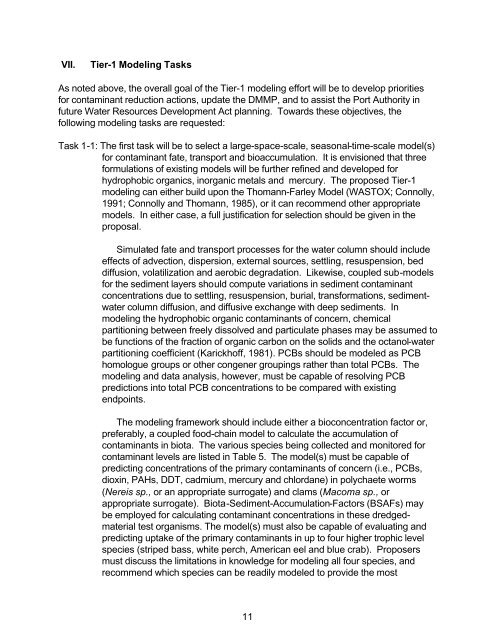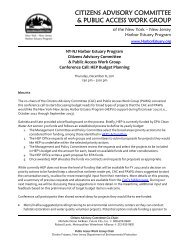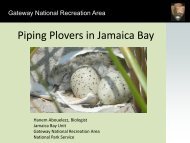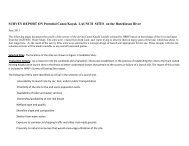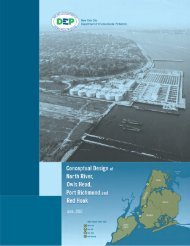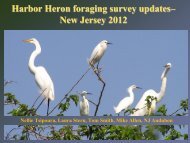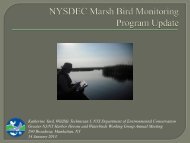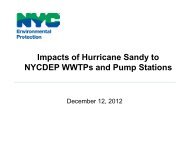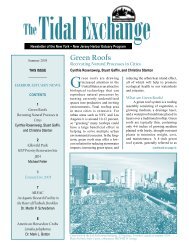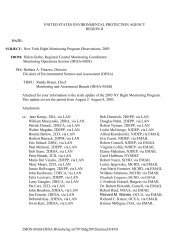A Model for the Evaluation and Management of Contaminants of ...
A Model for the Evaluation and Management of Contaminants of ...
A Model for the Evaluation and Management of Contaminants of ...
You also want an ePaper? Increase the reach of your titles
YUMPU automatically turns print PDFs into web optimized ePapers that Google loves.
VII.<br />
Tier-1 <strong>Model</strong>ing Tasks<br />
As noted above, <strong>the</strong> overall goal <strong>of</strong> <strong>the</strong> Tier-1 modeling ef<strong>for</strong>t will be to develop priorities<br />
<strong>for</strong> contaminant reduction actions, update <strong>the</strong> DMMP, <strong>and</strong> to assist <strong>the</strong> Port Authority in<br />
future Water Resources Development Act planning. Towards <strong>the</strong>se objectives, <strong>the</strong><br />
following modeling tasks are requested:<br />
Task 1-1: The first task will be to select a large-space-scale, seasonal-time-scale model(s)<br />
<strong>for</strong> contaminant fate, transport <strong>and</strong> bioaccumulation. It is envisioned that three<br />
<strong>for</strong>mulations <strong>of</strong> existing models will be fur<strong>the</strong>r refined <strong>and</strong> developed <strong>for</strong><br />
hydrophobic organics, inorganic metals <strong>and</strong> mercury. The proposed Tier-1<br />
modeling can ei<strong>the</strong>r build upon <strong>the</strong> Thomann-Farley <strong>Model</strong> (WASTOX; Connolly,<br />
1991; Connolly <strong>and</strong> Thomann, 1985), or it can recommend o<strong>the</strong>r appropriate<br />
models. In ei<strong>the</strong>r case, a full justification <strong>for</strong> selection should be given in <strong>the</strong><br />
proposal.<br />
Simulated fate <strong>and</strong> transport processes <strong>for</strong> <strong>the</strong> water column should include<br />
effects <strong>of</strong> advection, dispersion, external sources, settling, resuspension, bed<br />
diffusion, volatilization <strong>and</strong> aerobic degradation. Likewise, coupled sub-models<br />
<strong>for</strong> <strong>the</strong> sediment layers should compute variations in sediment contaminant<br />
concentrations due to settling, resuspension, burial, trans<strong>for</strong>mations, sedimentwater<br />
column diffusion, <strong>and</strong> diffusive exchange with deep sediments. In<br />
modeling <strong>the</strong> hydrophobic organic contaminants <strong>of</strong> concern, chemical<br />
partitioning between freely dissolved <strong>and</strong> particulate phases may be assumed to<br />
be functions <strong>of</strong> <strong>the</strong> fraction <strong>of</strong> organic carbon on <strong>the</strong> solids <strong>and</strong> <strong>the</strong> octanol-water<br />
partitioning coefficient (Karickh<strong>of</strong>f, 1981). PCBs should be modeled as PCB<br />
homologue groups or o<strong>the</strong>r congener groupings ra<strong>the</strong>r than total PCBs. The<br />
modeling <strong>and</strong> data analysis, however, must be capable <strong>of</strong> resolving PCB<br />
predictions into total PCB concentrations to be compared with existing<br />
endpoints.<br />
The modeling framework should include ei<strong>the</strong>r a bioconcentration factor or,<br />
preferably, a coupled food-chain model to calculate <strong>the</strong> accumulation <strong>of</strong><br />
contaminants in biota. The various species being collected <strong>and</strong> monitored <strong>for</strong><br />
contaminant levels are listed in Table 5. The model(s) must be capable <strong>of</strong><br />
predicting concentrations <strong>of</strong> <strong>the</strong> primary contaminants <strong>of</strong> concern (i.e., PCBs,<br />
dioxin, PAHs, DDT, cadmium, mercury <strong>and</strong> chlordane) in polychaete worms<br />
(Nereis sp., or an appropriate surrogate) <strong>and</strong> clams (Macoma sp., or<br />
appropriate surrogate). Biota-Sediment-Accumulation-Factors (BSAFs) may<br />
be employed <strong>for</strong> calculating contaminant concentrations in <strong>the</strong>se dredgedmaterial<br />
test organisms. The model(s) must also be capable <strong>of</strong> evaluating <strong>and</strong><br />
predicting uptake <strong>of</strong> <strong>the</strong> primary contaminants in up to four higher trophic level<br />
species (striped bass, white perch, American eel <strong>and</strong> blue crab). Proposers<br />
must discuss <strong>the</strong> limitations in knowledge <strong>for</strong> modeling all four species, <strong>and</strong><br />
recommend which species can be readily modeled to provide <strong>the</strong> most<br />
11


